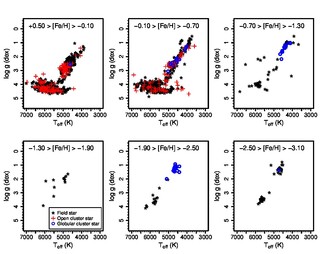
The Gaia-ESO Survey is an ambitious spectroscopic survey that is observing more than 100000 Galactic stars. Spectra of medium- and high-resolution are being collected with the FLAMES multi-fiber spectrograph of the European Southern Observatory (ESO), at the 8 meters Very Large Telescope (VLT), in Cerro Paranal, Chile. Observations started in December 2011 and will last for 4 years for a total 300 nights. The Gaia-ESO Survey involves more than 300 astronomers, mostly from European institutes.
The Survey is observing stars in all components of the Milky Way (the thin and thick disks, the bulge, and the halo). It is also observing stars in 80 open clusters of different ages and metallicities. The targets include stars of several spectral types (from O- to M-type) and in distinct stages of their evolution (giants, dwarfs, and pre-main-sequence stars).
The goal is to provide a large overview of the kinematics and chemical composition of stars in the Galaxy. This is an important information to understand the history of formation and evolution of the Milky Way. In addition, studying the open cluster stars will contribute to improve our understanding of stellar evolution from the pre-main sequence to the red giant stage.
The Survey recently reached an important milestone when the analysis of all spectra obtained up to the end of June 2013 was completed (1.5 years of observations). The analysis of the high-resolution spectra of FGK-type stars is described in a recent paper "The Gaia-ESO Survey: The analysis of high-resolution UVES spectra of FGK-type stars" by R. Smiljanic (of the Nicolaus Copernicus Astronomical Center) and collaborators published in the Astronomy & Astrophysics journal. The importance of this milestone for the Survey made the paper one of the research highlights of that edition.
This paper describes how the atmospheric parameters and elemental abundances were determined for 1301FGK-type stars. This sample is already among the largest of its kind analyzed in a homogeneous way. These stars are mainly dwarfs in the solar neighborhood and giants in a few open clusters with ages above 100 Myr. Abundances were determined for 24 chemical elements: C, N, O, Na, Mg, Al, Si, Ca, Sc, Ti, V, Cr, Mn, Fe, Co, Ni, Cu, Zn, Y, Zr, Mo, Ba, Nd, and Eu. The list includes elements formed in all nucleosynthetic channels. The results will enable significant advances in the areas of stellar evolution and Milky Way formation and evolution. Many other publications based on these results have already been published or are under
preparation.
(Text: Rodolfo Smiljanic.)
Figure: The observed stars in the effective temperature vs. surface gravity plane. The panels are divided by metallicity. The figure shows the distribution of the stars in different evolutionary stages per metallicity interval.






